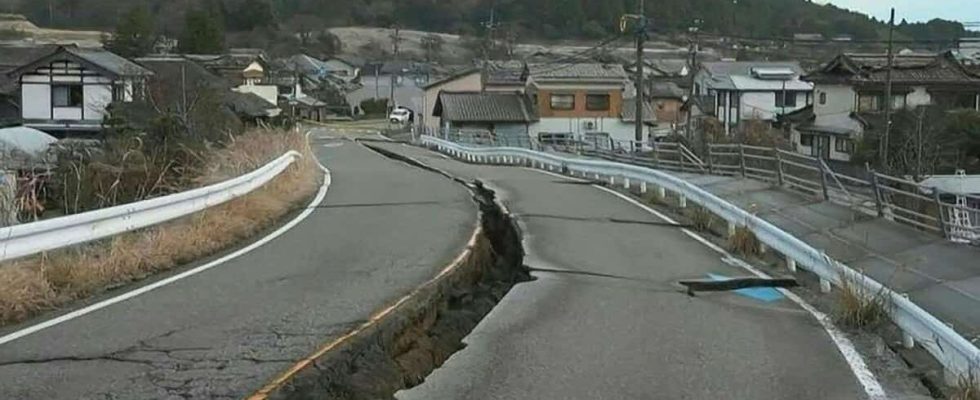A race against time was launched on Tuesday in Japan to find survivors after an earthquake which devastated the Noto peninsula, in the center of the country, on Monday and killed 50 people according to a provisional toll.
• Read also: Central Japan hit by 155 earthquakes since Monday
• Read also: Five dead in plane collision at Tokyo Haneda Airport
“The total number of deaths has reached 48,” an official from the Ishikawa department, of which the Noto peninsula is part, told AFP on Tuesday. A previous report reported 30 deaths.
“It was such a powerful shock,” Tsugumasa Mihara, 73, told AFP, queuing with hundreds of other residents of Shika, a small town on the Noto peninsula, to recover from drinking water at the town hall.
“What a terrible way to start the year,” he added.
AFP
Occurring Monday at 4:10 p.m. (7:10 a.m. GMT), this earthquake, the most powerful among more than 150 significant tremors felt until Tuesday morning, was recorded at a magnitude of 7.5 according to the American Institute of Geophysics (USGS) and 7.6 according to the Japan Meteorological Agency (JMA).
This earthquake, felt as far as Tokyo, 320 km as the crow flies from Noto, also caused considerable material damage and a tsunami on Monday on the coasts of the Sea of Japan, which ultimately remained of low magnitude, waves up to 1.2 m high having been measured.
The tsunami risk level, which initially triggered a rare maximum alert from the JMA, was then downgraded in the evening and then definitively lifted on Tuesday at 10 a.m. (1 a.m. GMT).
The extent of the destruction was revealed at daybreak on Tuesday: everywhere, old houses and collapsed buildings, cracked roads, fishing boats having capsized or run aground, and persistent fires in the middle of smoking ruins. .
The earthquake and its multiple aftershocks caused “numerous victims” and significant material damage, Japanese Prime Minister Fumio Kishida said on Tuesday. “We must race against time” to save lives, he added.
A large fire notably ravaged part of the city center of Wajima, a small historic port in the north of the Noto peninsula known for its artisanal lacquer products. A six-story commercial building also collapsed due to the earthquake.
“Hold fast! Hold on!” shouted firefighters as they made their way through the rubble using an electric saw and by crawling, according to images from Japanese television filmed in Wajima.
Some 32,000 homes remained without electricity on Tuesday afternoon and many towns in Ishikawa department no longer have access to drinking water, while winter brings cold and humidity to this rural region.
More than 60,000 residents had received evacuation instructions on Monday, according to the national fire and natural disaster management agency.
A thousand soldiers from the Japan Self-Defense Forces (JSF), as well as more than 2,000 firefighters and some 630 police officers have arrived as reinforcements in the disaster areas, Mr. Kishida said on Tuesday.
The Prime Minister also announced on Monday the sending of essential goods such as drinking water, food, blankets, gasoline and even fuel oil, by plane or by boat.
Imperial New Year greetings canceled
Faced with the disaster, the traditional public New Year greetings by Japan’s Emperor Naruhito and his family, which were to be held in Tokyo on Tuesday, were canceled.
Several damaged highways were closed to traffic and high-speed train (shinkansen) traffic between Tokyo and Ishikawa, interrupted since Monday, resumed Tuesday afternoon.
But some 2,400 passengers were stuck overnight on shinkansen or other stopped trains, some for nearly 24 hours, according to NHK. Around 500 people were also stranded at Noto airport, whose runway and access roads were damaged.
Located on the Pacific Ring of Fire, Japan is one of the countries with the most frequent earthquakes in the world.
The archipelago therefore has extremely strict construction standards, so modern buildings are generally resistant to powerful earthquakes, but older houses much less so.
Japan is haunted by the memory of the terrible magnitude 9 earthquake followed by a giant tsunami in March 2011 on the northeast coast of the country, a disaster which left some 20,000 dead and missing.
This disaster also led to the Fukushima nuclear accident, the worst since Chernobyl in 1986.
“No anomaly” has been detected in the country’s nuclear power plants, the Japanese nuclear safety authority (NRA) assured on Monday.
Several friendly countries of Japan including the United States, Canada, France and Italy have offered Tokyo to help, if necessary. China also expressed its condolences on Tuesday.
